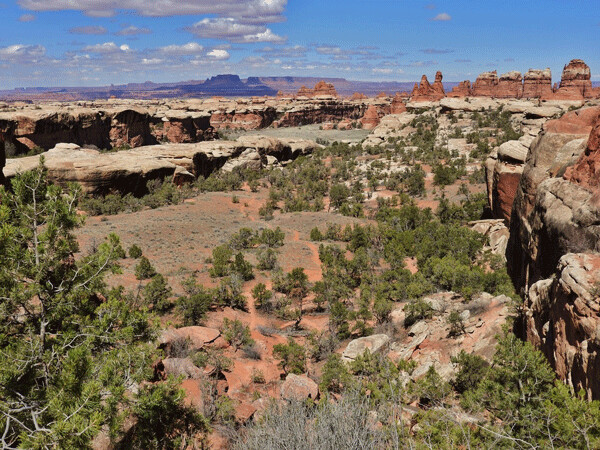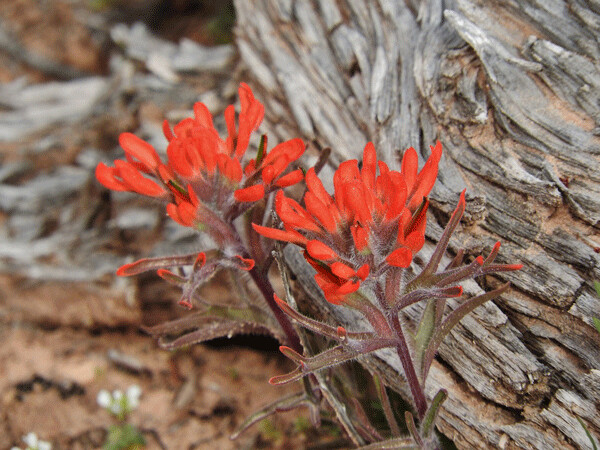News & Articles
Browse all content by date.

My hiking boots gripped the buff-colored sandstone with a satisfying security as the cairn-marked trail stretched out in front of me. This relatively flat, solid stretch was a treat after long sections of loose sand interspersed with mountain goat-style climbing up and down the sandstone spires. No one has ever accused the Needles District of Canyonlands National Park of being monotonous. Its geologically sculpted spires of red and white sandstone, which are divided by washes, canyons, joints, and towering walls, provide a pretty varied view.
The desert is supposed to be hot, but my friend Jamie and I were grateful for a chill in the air on this clear-eyed morning. Climbing up and over notches and carrying packs heavy with a day’s worth of water provided us with plenty of internal warmth.
There was one disappointing thing about the cold, though. While California splashed photos of their Super Bloom all over the news, this high desert of Utah has experienced a cool spring, and the familiar flowers we remembered from our internship here back in 2005, were still either hidden deep, or just poking up as unrecognizable spikes of green. It was probably better that way, because Jamie and I now both own nice cameras with macro lenses, and a Super Bloom here would have prevented us from ever completing a loop trail before dark. We still found plenty of beauty to enjoy.
For example, as my stiff knees creaked up from a patch of cryptobiotic crust I’d been admiring, a shock of red caught the corner of my eye. Thrilled, I turned my camera on the scarlet tuft of common Indian paintbrush flowers sticking up out of a little rock garden. Ah, now these were an old favorite.



The eye-catching red of the plant doesn’t belong to its petals, though. To a botanist, the crimson “bristles” of the paintbrush are bracts. On most flowering plants the bracts look more like leaves, and guard the blossoms from farther down on the stem. On Indian paintbrush, the bracts are showy, and cluster protectively around the inconspicuous, green, tubular flowers which cradle the plant’s reproductive parts.
This is really a bit of semantics, though, if you’re not a botany student studying for a test. The real trickery of Indian paintbrush lies much deeper.
If I were to gently extricate this plant from the sandy soil without breaking any of its roots, I would soon be tugging at nearby plants as well. Indian paintbrush roots don’t bother to grow very long themselves, but they do send out illicit appendages, called haustoria, that tap into the plumbing of their neighbors to siphon off water and minerals without giving anything in return. The desert is a harsh, dry place with poor soils, and I can’t say I blame Indian paintbrush for a bit of bootlegging to make ends meet.
Anyway, it could be worse. Plenty of plants have given up on honorably acquiring their own resources altogether, and those parasites steal carbon as well as water. They don’t even bother to have green leaves, and have lost the ability to carry out photosynthesis. At least Indian paintbrush still has green leaves and makes most of its own sugar. It’s classified as a “hemiparasite,” which means it’s only half parasitic.
Sometimes the most valuable resource that an Indian paintbrush can steal from its neighbor isn’t food, it’s poison. Some plants produce or absorb chemical alkaloids that can be toxic to animals. For example, a group of plants called “locoweeds” produce alkaloids that can be dangerous to livestock. In one study, scientists found that the alkaloids which Indian paintbrush stole from its neighbor helped protect it against attacks by insect pests. This increased the number of intact flowers and the number of visits by pollinators.
It’s not a total freeloader, though. Indian paintbrush’s success can be transferred to the
Edith’s checkerspot butterfly. When its caterpillar feeds on a robust Indian paintbrush that’s getting plenty nitrogen and alkaloids from its host, the caterpillar grows faster, and sequesters more of the protective glycosides—chemicals similar to the ones that monarch caterpillars get from milkweed.
Happily, Jamie and I continued to spot flashes of red nestled among rocks, grasses, and bushes along all the trails we hiked during our four days in Canyonlands. Because of Indian paintbrush’s lifestyle, it tends to grow here and there among other plants instead of in big patches by itself, and spotting its crimson bracts feels a little like a treasure hunt.
In fact, various species of Indian paintbrush grow across North America, south to the Andes, in northern Asia, and as far away as northwestern Russia. Personally I’ve spotted red or yellow versions of them in Wisconsin, Iowa, California, Alaska, and across the Great Plains. Wherever you go, I hope this crafty paintbrush splashes a bit of color along your hikes, too.
Emily’s second book, Natural Connections: Dreaming of an Elfin Skimmer, is now available to purchase at www.cablemuseum.org/books and will soon be available at your local independent bookstore, too.
For 50 years, the Cable Natural History Museum has served to connect you to the Northwoods. Come visit us in Cable, WI! Our new Curiosity Center kids’ exhibit will open May 4.
| Tweet |


